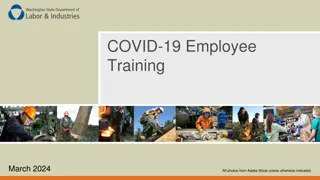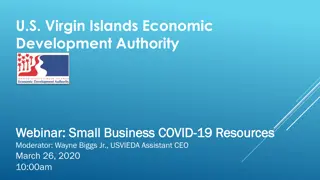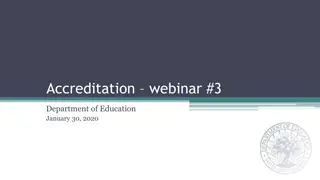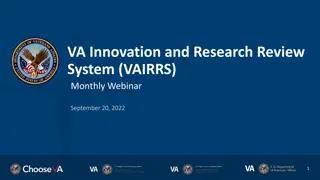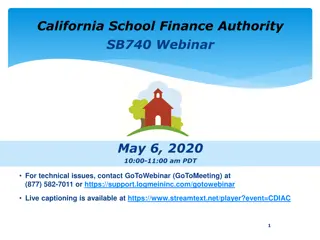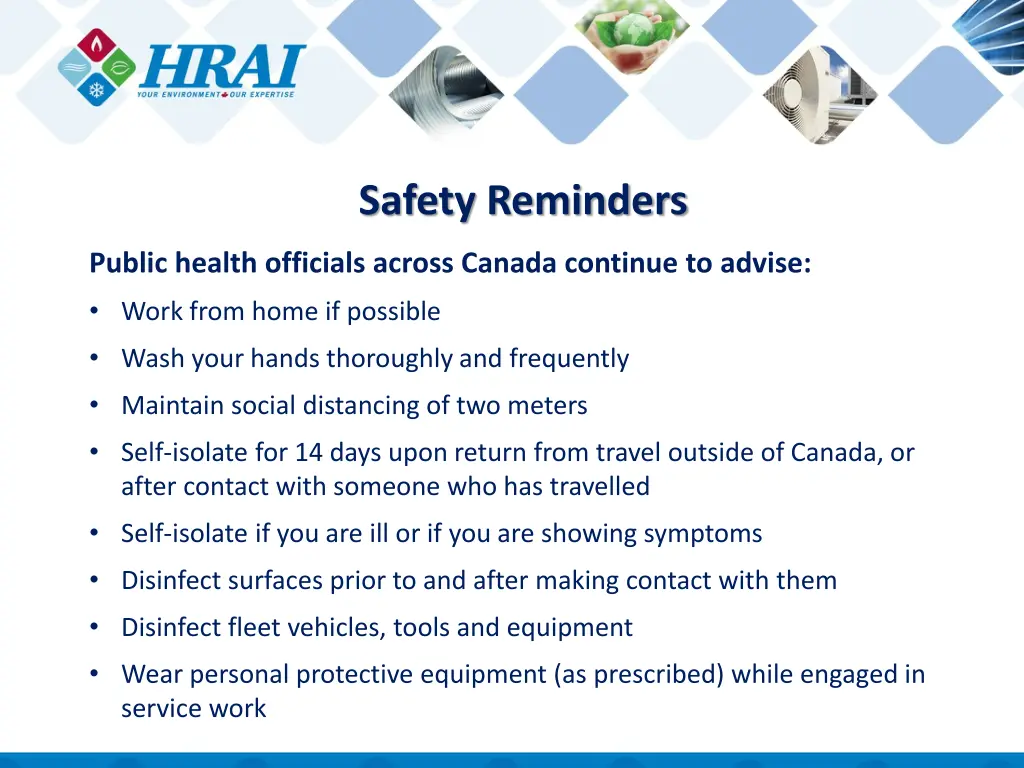
Effective Safety Reminders and HR Management Strategies in Canada
Public health officials in Canada advise work-from-home measures, stringent hygiene practices, social distancing, and self-isolation protocols in response to COVID-19. Explore insights on managing HR issues and accessing government support programs amid the pandemic.
Download Presentation

Please find below an Image/Link to download the presentation.
The content on the website is provided AS IS for your information and personal use only. It may not be sold, licensed, or shared on other websites without obtaining consent from the author. If you encounter any issues during the download, it is possible that the publisher has removed the file from their server.
You are allowed to download the files provided on this website for personal or commercial use, subject to the condition that they are used lawfully. All files are the property of their respective owners.
The content on the website is provided AS IS for your information and personal use only. It may not be sold, licensed, or shared on other websites without obtaining consent from the author.
E N D
Presentation Transcript
Safety Reminders Public health officials across Canada continue to advise: Work from home if possible Wash your hands thoroughly and frequently Maintain social distancing of two meters Self-isolate for 14 days upon return from travel outside of Canada, or after contact with someone who has travelled Self-isolate if you are ill or if you are showing symptoms Disinfect surfaces prior to and after making contact with them Disinfect fleet vehicles, tools and equipment Wear personal protective equipment (as prescribed) while engaged in service work
COVID COVID- -19 Impacts 19 Impacts on on Human Resources Management Human Resources Management for for Small and Medium Small and Medium- -sized Businesses sized Businesses Wednesday, April 7th
Purpose of this Webinar Federal government support programs for businesses and their employees How to manage HR Issues that arise form the COVID-19 pandemic
Francesco Sorbara Member of Parliament Vaughan-Woodbridge Parliamentary Secretary to the Minister of National Revenue
Mike Salveta & Kelsey Livesay Pivotal Solutions
Agenda Agenda Most Frequently Asked Questions Reducing your Costs Other Options for Business to Weather the Storm Don t Forget about Recovery HRAI COVID-19 HR Helpdesk
Employer Employer FAQs FAQs It is my understanding that we are strongly encouraged to try and keep each of our employees working if possible. We have had a few sites shut down due to health and safety concerns. Only applies if you qualify for the Federal Wage Subsidy Otherwise you are free to balance your headcount and cost with your revenue and workload requirements
Employer FAQs Employer FAQs We are being told that we have to pay severance packages to employees that are being placed on a temporary layoff (for now until end of June). Possible if constructive dismissal, but a longshot Practically, providing you are not singling out a worker or group of workers, you will not face a constructive dismissal claim and you do not have to pay termination payments, provided: The layoff is temporary, in writing and has a recall date of 13 weeks or 35 weeks if you continue benefits; Once the recall date has passed, the employee is then deemed terminated and termination pay applies.
Employer Employer FAQs FAQs Do you have any information of how the Employment Standards Act applies for people who have been with the company for over 10 years? There are three provisions that impact termination pay: Notice up to 8 weeks for 8 years service; Severance for employees over 5 years service and an employer with over 2.5 million in annual payroll, 1 week per completed year of service up to 26 weeks; Common (judge-based) Law companies without a valid termination clause in their employment agreements face an addition sum representing the likely time required to seek alternative employment (based on factors such as age, position, salary, industry and skills).
Employer Employer FAQs FAQs Are Companies paying risk pay to technicians? Perhaps, but we have strongly recommended against using the term risk or danger. Employees are expected to return to work (unless a bona fide work refusal or medical condition justifies staying away). We recommend it being structured as a performance incentive, based on achieving a standard (e.g. successful repair no fail, etc.).
Employer Employer FAQs FAQs We have an Employee who says they may have symptoms or have been exposed to someone with the COVID-19 virus. What should we do? Send the employee(s) home and recommend they consult with public health or a medical professional. They should not return to work for at least 14 days or until cleared by Health authorities. You should advise co-workers who worked with them (no names) that a co- worker has been sent home. They should self monitor. Conduct a deep disinfecting of the path of travel in addition to regular enhanced cleaning in all your operations. With co-workers, encourage increased social distancing in the workplace stay 3+ meters apart if possible, stagger breaks, lunches and shifts.
Employer Employer FAQs FAQs An employee has tested positive for COVID-19 what does the employer do? The employee should not be permitted to return to the workplace until they are free of the COVID-19 virus. All employees who worked closely with the infected employee should also be removed from the workplace for at least a 14-day period to ensure the infection does not spread in the workplace. Closely will depend on the nature of interactions between employees. Employers should err on the side of caution. Employers should also take reasonable measures, to the extent possible, to protect the privacy of any employee who contracts COVID-19.
Employer Employer FAQs FAQs If we lay off our employees, are they still covered under our benefit plans? This will depend on the language of the benefit plan document. Employers must review their policies with their benefit plan provider and advise employees of any limitations or restrictions in coverage.
Employer Employer FAQs FAQs What if employees refuse to work because they are afraid of contracting COVID-19 in the workplace? Employers have an obligation to take reasonable care to protect the health and safety of employees under occupational health and safety legislation. In the event of a work refusal, the employer must respond in accordance with Provincial or Federal occupational health and safety legislation. Whether or not a work refusal is reasonable will depend on individual circumstances. In the event of a work refusal, the employer must respond in accordance with occupational health and safety legislation, which response will include an investigation into the concerns and, if appropriate, adopting measures to eliminate or reduce the workplace danger. This investigation will, in large part, be based upon the current scientific understanding of COVID- 19 and the specific facts in the individual workplace. No reprisal for properly exercising a health and safety right may occur.
Employer Employer FAQs FAQs Can we require employee who work from home to provide proof that they are, in fact, working? Yes, within reason, employers can ask employees who work from home to demonstrate that they are performing work duties (e.g. submitting a simple log or report at the end of the day/week). However, employers must not impose new supervisory or management controls. For example, if employees at work are not subjected to a time clock to monitor how much time they spend logged into a project management app, then introducing one for employees at home is likely to be inappropriate. Create a policy which outlines all expectations from service to availability
Employers Employers - - Reducing Your Costs Reducing Your Costs As an employer, you potentially have the following seven options to reduce your labour costs: Payroll subsidy Eligible businesses, Canadian Controlled Private Corporations (CCPC), now including non-profits, charities as well as large and small companies whose revenues have decreased by at least 30% due to COVID-19 will apparently qualify for the subsidy. The subsidy will cover up to 75% of wages on the first $58,700 that an employee earns, up to a maximum of $847 a week subsidy for 12 weeks (March 15 to June 6). For eligible employers, this "Canada Emergency Wage Subsidy" will apply instead of the existing 10% wage subsidy program. Organizations that do not qualify for the new 75% wage subsidy continue to be eligible for the existing 10% wage subsidy on remuneration paid from March 18 to June 19, up to a maximum of $1,375 per employee and $25,000 per employer. Reduce compensation Some employers are temporarily and unilaterally reducing employee compensation packages by 5-20% Possibility of employees claiming constructive dismissal (i.e. that they were effectively fired) If an employee does claim that they were constructively dismissed then, as an employer, you will have to decide whether to: i) reverse the reduction, ii) deny the dismissal, or iii) admit the dismissal and undermine the claim.
Employers Employers - - Reducing Your Costs Reducing Your Costs Reduce hours of work Some employers are temporarily and unilaterally reducing employee hours of work If you are going to reduce hours of work, then you have three options: reduce hours immediately, without any government assistance; Lay off staff and then recall them for part-time work; or reduce hours under the Work Sharing Program. An employee may remain on layoff and be called in for part-time work or an odd job (i.e. work that is less than 40% of a regular work week)
Employers Employers - - Reducing Your Costs Reducing Your Costs Schedule vacations As an employer, you may unilaterally schedule week-long vacations for all or some of your employees By scheduling vacations, you are addressing a liability (or a future liability) and are ensuring a proper compliment when your labour needs pick up again Place employees on unpaid leaves In order to reduce your labour costs, you may wish to accept many or all of the requests you receive for an unpaid leave of absence
Employers Employers - - Reducing Your Costs Reducing Your Costs Temporarily lay off employees You may place your employees on an unpaid layoff for up to 13 weeks in a 20 consecutive weeks period (without benefits) There are, however, exceptions that allow for the temporary layoff to be extended to not more than 35 weeks in a 52 consecutive weeks period For example, employees can be laid off for 35 weeks if you continue to pay for their benefits Employees who are temporarily laid off may be eligible for traditional EI Benefits -- up to $573 per week for up to 45 weeks
Employers Employers - - Reducing Your Costs Reducing Your Costs Dismiss employees If the employee is not recalled from layoff within 13 weeks or 35 weeks In Ontario, as a result of the dismissal, generally the employee will be entitled to their minimal entitlements under the ESA and wrongful dismissal damages under the common law (judge based law) However, a properly drafted termination provision limits an employee to just their ESA entitlements or some other greater defined entitlement
Options To Weather the Storm (Stand alone or Options To Weather the Storm (Stand alone or in Combination) in Combination) Maximize work schedules and increase social distancing by staggering shifts (24/7). Implement the EI Work Sharing Program. Improvements include a streamlined application process, extended eligibility and less restrictive recovery plans. Work at home wherepractical. If not, perhaps on a rotation Offer extra days of unpaid leave. Extra vacation time is something many employees will find agreeable, even if it s unpaid. Communicate and stay in touch Contacts, software and groups. Find reasons to connect with updates from your Benefits provider.
Dont Forget About Don t Forget About Recovery Recovery Retention and Engagement will be a strategic advantage and lead to opportunity. Be Ready and Have a Plan. Be on the lookout for Talent. Early recovery firms will be cherry picking talent. Your employees could be susceptible to offers, Consideration to update all Employee handbooks and employment agreement with lessons learned Close off 2019 reviews, and programs Reforecast remaining 2020 plan and communicate expectations Align and set new Performance objectives, incentive plans and compensation plans to achieve 2020 / 2021 business plan. Train/Develop/Cross train Team Building / Communications (town halls etc.)
Questions? For the month of April, HRAI has made arrangements to have free access to get your HR questions answered by its HR partner. If the question is straightforward you will receive email guidance. If more complicated, a phone call. Send your question and contact information to: hrnews@pivotalsolutions.com

